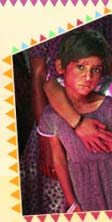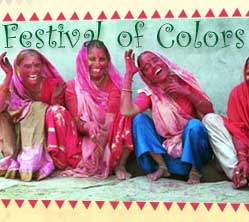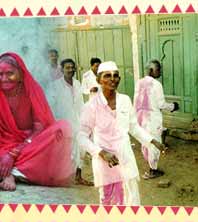On the first day of Holi or the full moon day,
colored powder known as 'gulal' is arranged on a 'thali' (platter) and
colored water is placed in a small brass pot known as 'lota'. As a good
omen, the eldest male member of the family sprinkle colors from the
'thali' and 'lota' on each member of the family. People light huge
bonfires at community grounds to commemorate the burning of Holika and a
new life granted to the child-devotee Prahlad. As the fire burns
brighter, people perform folk songs and drums on the rhythmic beats of
the drums around the bonfires and ask the blessings of the holy fire. In
some areas, people offer the first fruits, coconuts and harvest to the
holy fire.
The embers of this fire are then carried home and people light fire in
their houses from these embers. On the next day, children, men and women
form separate groups and visit each other's houses smearing each other's
faces and bodies with 'aabir' and 'gulal' and spurting colored water on
people using 'pichkaris' and water balloons. Youngers pay respects to
their elders by sprinkling some colors on their feet. Women decorate
their homes with flowers and traditional 'rangolis' made on the doorways
with colored rice powder or flowers and offer sweets, snacks and
'thandai', a milk-based cool drink to all those who visit their houses.
Holi marks the end of winter and the beginning of Spring. The festival
breathes an air of romance and social merriment. The young boys are
allowed to intoxicate themselves, use rude words and play pranks on
others. It is said that on this day, people befriend even their enemies
and make a new beginning. Celebrated predominantly in North India,
generally 'hasya kavi sammelan' or humor poem-meetings are arranged. At
some places, people even give out awards for being the biggest fool!
Traditionally, natural colors are prepared at home from flowers,
especially from Tesu and Palash.









